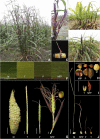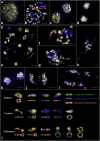Tripsazea, a Novel Trihybrid of Zea mays, Tripsacum dactyloides, and Zeaperennis
- PMID: 31792004
- PMCID: PMC7003090
- DOI: 10.1534/g3.119.400942
Tripsazea, a Novel Trihybrid of Zea mays, Tripsacum dactyloides, and Zeaperennis
Abstract
A trispecific hybrid, MTP (hereafter called tripsazea), was developed from intergeneric crosses involving tetraploid Zea mays (2n = 4x = 40, genome: MMMM), tetraploid Tripsacum dactyloides (2n = 4x = 72, TTTT), and tetraploid Zperennis (2n = 4x = 40, PPPP). On crossing maize-Tripsacum (2n = 4x = 56, MMTT) with Zperennis, 37 progenies with varying chromosome numbers (36-74) were obtained, and a special one (i.e., tripsazea) possessing 2n = 74 chromosomes was generated. Tripsazea is perennial and expresses phenotypic characteristics affected by its progenitor parent. Flow cytometry analysis of tripsazea and its parents showed that tripsazea underwent DNA sequence elimination during allohexaploidization. Of all the chromosomes in diakinesis I, 18.42% participated in heterogenetic pairing, including 16.43% between the M- and P-genomes, 1.59% between the M- and T-genomes, and 0.39% in T- and P-genome pairing. Tripsazea is male sterile and partly female fertile. In comparison with previously synthesized trihybrids containing maize, Tripsacum and teosinte, tripsazea has a higher chromosome number, higher seed setting rate, and vegetative propagation ability of stand and stem. However, few trihybrids possess these valuable traits at the same time. The potential of tripsazea is discussed with respect to the deployment of the genetic bridge for maize improvement and forage breeding.
Keywords: Tripsacum dactyloides; Zea mays; Zea perennis; forage breeding; maize improvement; trihybrid.
Copyright © 2020 Yan et al.
Figures





Similar articles
-
Allopolyploidization facilitates gene flow and speciation among corn, Zea perennis and Tripsacum dactyloides.Planta. 2019 Jun;249(6):1949-1962. doi: 10.1007/s00425-019-03136-z. Epub 2019 Mar 20. Planta. 2019. PMID: 30895446
-
Multispecies polyploidization, chromosome shuffling, and genome extraction in Zea/Tripsacum hybrids.Genetics. 2023 Apr 6;223(4):iyad029. doi: 10.1093/genetics/iyad029. Genetics. 2023. PMID: 36807971
-
Analysis of the genitor origin of an intergeneric hybrid clone between Zea and Tripsacum for forage production by McGISH.Breed Sci. 2020 Apr;70(2):241-245. doi: 10.1270/jsbbs.19107. Epub 2020 Feb 26. Breed Sci. 2020. PMID: 32523406 Free PMC article.
-
The genome organization and diversification of maize and its allied species revisited: evidences from classical and FISH-GISH cytogenetic analysis.Cytogenet Genome Res. 2005;109(1-3):259-67. doi: 10.1159/000082408. Cytogenet Genome Res. 2005. PMID: 15753585 Review.
-
Polyploidy in maize: from evolution to breeding.Theor Appl Genet. 2024 Jul 13;137(8):182. doi: 10.1007/s00122-024-04688-9. Theor Appl Genet. 2024. PMID: 39001883 Review.
Cited by
-
Integrated single-molecule real-time sequencing and RNA sequencing reveal the molecular mechanisms of salt tolerance in a novel synthesized polyploid genetic bridge between maize and its wild relatives.BMC Genomics. 2023 Jan 31;24(1):55. doi: 10.1186/s12864-023-09148-0. BMC Genomics. 2023. PMID: 36717785 Free PMC article.
-
Genome dosage alteration caused by chromosome pyramiding and shuffling effects on karyotypic heterogeneity, reproductive diversity, and phenotypic variation in Zea-Tripsacum allopolyploids.Theor Appl Genet. 2024 Jan 22;137(1):28. doi: 10.1007/s00122-023-04540-6. Theor Appl Genet. 2024. PMID: 38252297
-
Plant Biotechnology-An Indispensable Tool for Crop Improvement.Plants (Basel). 2024 Apr 18;13(8):1133. doi: 10.3390/plants13081133. Plants (Basel). 2024. PMID: 38674542 Free PMC article.
-
Maize-Tripsacum-Teosinte allopolyploid (MTP), a novel dwarf mutant inducer tool in maize.Plant Biotechnol J. 2025 Jan;23(1):112-127. doi: 10.1111/pbi.14483. Epub 2024 Oct 3. Plant Biotechnol J. 2025. PMID: 39361445 Free PMC article.
-
Identification and Genome-Wide Gene Expression Perturbation of a Trisomy in Chinese Kale (Brassica oleracea var. alboglabra).Plants (Basel). 2023 Sep 7;12(18):3199. doi: 10.3390/plants12183199. Plants (Basel). 2023. PMID: 37765363 Free PMC article.
References
-
- Bennetzen J. L., Buckler E. , Chandler V. , Doebley J., Dorweiler J. et al. , 2001. Genetic evidence and the origin of maize. Lat. Am. Antiq. 12: 84–86. 10.2307/971759 - DOI
-
- Cheng M., Zheng M., Yang S., Li Y., Dong X. et al. , 2016. The effect of different genome and cytoplasm on meiotic pairing in maize newly synthetic polyploids. Euphytica 207: 593–603. 10.1007/s10681-015-1552-7 - DOI
-
- De Wet J. M. J., Lambert R. J., Harlan J. R., and Naik S. M., 1970. Stable triploid hybrids among Zea-Tripsacum-Zea back-cross populations. Caryologia 23: 183–187.
Publication types
MeSH terms
LinkOut - more resources
Full Text Sources
